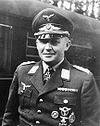
Operation Market Garden was an Allied military operation during the Second World War fought in the German-occupied Netherlands from 17 to 25 September 1944. Its objective was to create a 64 mi (103 km) salient into German territory with a bridgehead over the Nederrijn, creating an Allied invasion route into northern Germany. This was to be achieved by two sub-operations: seizing nine bridges with combined US and British airborne forces ("Market") followed by British land forces swiftly following over the bridges ("Garden").

The 1st Airborne Division was an airborne infantry division of the British Army during the Second World War. The division was formed in late 1941 during the Second World War, after the British Prime Minister, Winston Churchill, demanded an airborne force, and was initially under command of Major-General Frederick A. M. "Boy" Browning. The division was one of two airborne divisions raised by the British Army during the war, with the other being the 6th Airborne Division, created in May 1943, using former units of the 1st Airborne Division.

The 17th Airborne Division, "The Golden Talons", was an airborne infantry division of the United States Army during World War II, commanded by Major General William M. Miley.
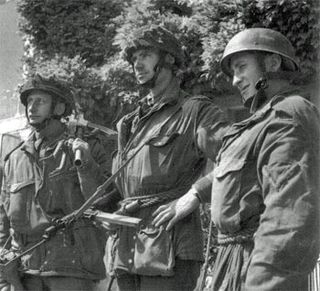
The 6th Airborne Division was an airborne infantry division of the British Army during the Second World War. Despite its name, the 6th was actually the second of two airborne divisions raised by the British Army during the war, the other being the 1st Airborne Division. The 6th Airborne Division was formed in the Second World War, in mid-1943, and was commanded by Major-General Richard N. Gale. The division consisted of the 3rd and 5th Parachute Brigades along with the 6th Airlanding Brigade and supporting units.
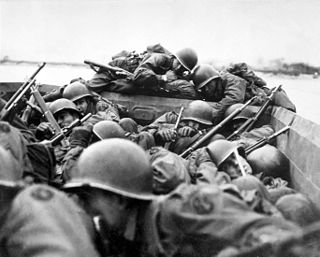
Operation Plunder was a military operation to cross the Rhine on the night of 23 March 1945, launched by the 21st Army Group under Field Marshal Bernard Montgomery. The crossing of the river was at Rees, Wesel, and south of the river Lippe by the British Second Army under Lieutenant General Miles Dempsey, and the United States Ninth Army under Lieutenant General William H. Simpson.

Operation Varsity was a successful airborne forces operation launched by Allied troops toward the end of World War II. Involving more than 16,000 paratroopers and several thousand aircraft, it is the largest airborne operation ever conducted on a single day and in one location.

The I Airborne Corps was an airborne forces corps raised by the British Army during the Second World War. Together with the U.S. XVIII Airborne Corps it was part of the First Allied Airborne Army.
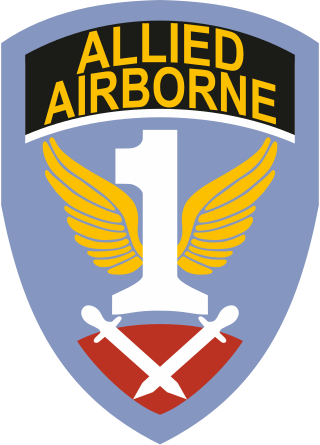
The First Allied Airborne Army was an Allied formation formed on 2 August 1944 by the order of General Dwight D. Eisenhower, the Supreme Allied Commander of the Allied Expeditionary Force.

Operation Veritable was the northern part of an Allied pincer movement that took place between 8 February and 11 March 1945 during the final stages of the Second World War. The operation was conducted by Field Marshal Bernard Montgomery's Anglo-Canadian 21st Army Group, primarily consisting of the First Canadian Army under Lieutenant-General Harry Crerar and the British XXX Corps under Lieutenant-general Brian Horrocks.

Alfred Schlemm was a German General der Fallschirmtruppe in the Wehrmacht. His last command in World War II opposed the advance of the First Canadian Army through the Reichswald in February 1945.

The 1st Parachute Brigade, or the Red Devils, was an airborne forces brigade formed by the British Army during the Second World War. As its name indicates, the unit was the first parachute infantry brigade formation in the British Army.

The Western Allied invasion of Germany was coordinated by the Western Allies during the final months of hostilities in the European theatre of World War II. In preparation for the Allied invasion of Germany east of the Rhine, a series of offensive operations were designed to seize and capture its east and west banks: Operation Veritable and Operation Grenade in February 1945, and Operation Lumberjack and Operation Undertone in March 1945; these are considered separate from the main invasion operation. The Allied invasion of Germany east of the Rhine started with the Western Allies crossing the river on 22 March 1945 before fanning out and overrunning all of western Germany from the Baltic in the north to the Alpine passes in the south, where they linked up with troops of the U.S. Fifth Army in Italy. Combined with the capture of Berchtesgaden, any hope of Nazi leadership continuing to wage war from a so-called "national redoubt" or escape through the Alps was crushed, shortly followed by unconditional German surrender on 8 May 1945. This is known as the Central Europe Campaign in United States military histories.

The 6th Airlanding Brigade was an airborne infantry brigade of the British Army during the Second World War. Created during May 1943, the brigade was composed of three glider infantry battalions and supporting units, and was assigned to the 6th Airborne Division, alongside the 3rd and 5th Parachute Brigades.

Brigadier Stanley James Ledger Hill, was a British Army officer, who served as commander of the 3rd Parachute Brigade, part of the 6th Airborne Division, during the Second World War.

Army Group H was a German army group during World War II, active between November 1944 and May 1945. It was deployed mainly in the German-occupied Netherlands. The staff was known as Supreme Commander North West from 7 April. The army group surrendered at Lüneburg Heath on 4 May 1945.
The 711th Infantry Division was a German Army infantry division in World War II.

The 9th Parachute Battalion was an airborne infantry battalion of the Parachute Regiment, raised by the British Army during the Second World War. The battalion was created in late 1942 by the conversion of the 10th Battalion, Essex Regiment to parachute duties. The battalion was assigned to the 3rd Parachute Brigade, alongside the 7th and 8th Parachute battalions, then part of the 1st Airborne Division but was later transferred to the 6th Airborne Division.

The Fallschirmjäger were the paratrooper branch of the German Luftwaffe before and during World War II. They were the first paratroopers to be committed in large-scale airborne operations. They were commanded by Kurt Student, the Luftwaffe's second-in-command.

The 1st Airlanding Light Regiment was an airborne forces unit of the British Army's Royal Artillery during the Second World War.
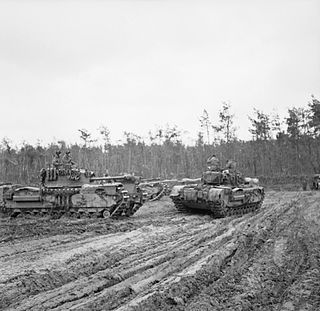
The Rhineland Offensive was a series of allied offensive operations by 21st Army Group commanded by Bernard Montgomery from 8 February 1945 to 25 March 1945, at the end of the Second World War. The operations were aimed at occupying the Rhineland and securing a passage over the Rhine river.

